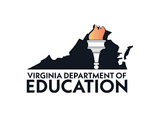
English Instructional Plan: Addressing Themes, Characters, and Motifs in African American Literature
- Subject:
- English
- Reading
- Material Type:
- Lesson Plan
- Author:
- VDOE Project Team
- Date Added:
- 04/19/2022

English Instructional Plan: Addressing Themes, Characters, and Motifs in African American Literature
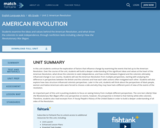
In this unit students continue the exploration of factors that influence change by examining the events that led up to the American Revolution. Over the course of the unit, students will build a deeper understanding of the significant ideas and values at the heart of the American Revolution, what drove the colonists to seek independence, and how conflict between England and the colonists ultimately influenced change in our country. Students will see the American Revolution from multiple perspectives, starting with analyzing the difference in perspectives between the British and the colonists and how each side's actions often instigated each other. Students will also explore how class structure influenced colonists perspectives. Later in the unit, students will think about the perspectives of black people, women and Native Americans who were forced to choose a side and why they may have had a different point of view of the events of the revolution.
An important part of this unit is pushing students to focus on seeing history from multiple different perspectives. The core text Liberty! How the Revolutionary War Began offers one perspective on events, however, the prespective is limited to that held by white elite colonists. Therefore, students also read excerpts from A Young People's History of the United States in order to build a deeper understanding of all sides of the Revolution.

Analyze and describe the role of imagery in poems linked by theme.
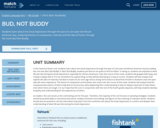
In this historical fiction unit, students learn about the Great Depression through the eyes of a ten-year-old African-American boy by reading the core text Bud, Not Buddy. In Bud, Not Buddy, students join Bud on his quest to find his father. In doing so, students are exposed to what life was like during the Great Depression, especially for African-Americans. Over the course of the novel, students will grapple with lying, and if lying is always bad or if it can sometimes be a good thing, as they witness Bud lying as a way to survive. Students will also analyze and explore the idea of maturity and what it means to act one's age versus acting more mature as Bud finds himself in situations most ten-year-olds will never experience. The theme of compassion and kindness also arises over the course of the novel. Students will analyze how the compassionate actions of others help Bud on his journey, while deepening their understanding of why it's always important to help others, even when times are tough. It is our hope that this unit, in conjunction with the rest of the fourth-grade sequence, will help students develop empathy and understanding for the experiences of others.
As readers, this unit serves as the culminating unit for the year. Therefore, the majority of the unit focuses on spiraling strategies. Students should be pushed daily to summarize key events, analyze characters and setting, and figure out the meaning of unknown words. Students should also be pushed to use the information they learn from the nonfiction text about the Great Depression to confirm and deepen their understanding of what life was like during the Great Depression.
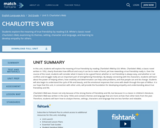
In this unit, students will explore the meaning of true friendship by reading Charlotte's Web by E.B. White. Charlotte's Web, a classic novel written in 1952, clearly illustrates how difficult and scary it can be to make a friend, yet how rewarding a true friendship really is. Over the course of the novel, students will consider what it means to be a good friend, whether or not friendship is always easy, and whether or not conflicts and struggle really are an important part of strengthening friendships. By deeply connecting with the characters, students will learn about the power of helping others, how creativity and determination can help solve problems, and that people can and do change. Students will also begin to understand the cycle of life and beauty, and the emotional responses that come with death through the eyes of Wilbur. It is our hope that this unit, in connection with other units, will provide the foundation for developing empathy and understanding about true friendship and life.
Charlotte's Web was chosen not only because of the strong theme of friendship and life, but because it is a classic in children's literature. Charlotte's Web was written in the early 1950s and contains themes and language that are more archaic than other texts from the year. Therefore, students will learn how to analyze themes, settings, characters and language that are less familiar and relatable.
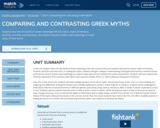
In this unit students dive into the world of Greek mythology. Over the course of the unit students will read the classic myths of Pandora, Arachne, and Echo and Narcissus. In reading the myths, students will gain a deeper understanding of the gods and mortals in ancient Greece and how the ancient Greeks used mythology as a way to make sense of and interpret the world around them. Students will also continue the thematic exploration from previous units about how a person's beliefs, ethics, or values influence that person's behavior.
Over the course of the unit, students will read multiple versions of the classic myths. The primary focus of this unit is on close reading and analyzing the differences among the versions and critically analyzing an author's choice of genre. In doing so, students will be challenged to think about how the structural elements of different genres, particularly prose, drama, and verse, allow a reader to better understand a story or text. Students will also explore how the point of view in which a story is written, either third-person point of view or first-person point of view, changes the way a story is told and the depth of information that a reader knows. Another focus of this unit is determining the central theme of the myths. Because the stories in this unit are shorter than the novels students have read so far, this unit offers students practice in finding the theme of a shorter text and explaining how the author uses evidence to develop the theme.
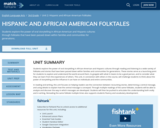
This unit connects with the third grade Social Studies Unit 1, Ancient Rome. In the Social Studies unit, students study and learn about the values and beliefs of the ancient Roman Empire. In this literature unit, students begin to see the role that myths, gods, and storytelling had in ancient Rome by reading a collection on Roman myths. While reading the myths, students will be challenged to think about how the myths illustrate and show the beliefs and customs of the Roman Empire. Students will also be challenged to think what the myths teach about retaliation and generosity.
In reading and writing, this unit focuses on helping readers solidify their understanding of the connection between recounting stories, determining a central message, and using details to explain how the central message is conveyed. Through multiple readings of the same myths, students will be able to analyze and discover the way in which messages are developed. Students will then be pushed to articulate this understanding both orally and in writing. Rereading the same myth multiple times also supports students fluency and vocabulary development.

This is a remix of the original resource provided by Elizabeth Huggin. In this activity, students will complete four tasks that will help them identify, analyze, and describe the role of imagery in poems linked by theme. Students will work individually or collaborate on different tasks, working through the process of identifying, illustrating, analyzing, and describing figurative language in a variety of poems. Differentiation options are provided within the activity as well.
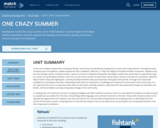
In this unit, students explore the meaning of family, community, and identity by reading the core text One Crazy Summer. Through the eyes of eleven-year-old Delphine, readers experience life in Oakland, California, in 1968, the height of the Black Panther movement. Delphine and her two younger sisters, Vonetta and Fern, spend a summer in Oakland visiting their estranged mother who sends them to spend their days at a camp run by the Black Panthers. Over the course of the summer, the girls learn about what it means to be part of a revolution, what the Black Panther Party was fighting for, and why the Black Panther Party was important during this time period. Through it all, they build confidence in themselves and their relationships with others as they learn to challenge and respond to social issues in the community. It is our hope that this unit, in conjunction with others in the series, will help students understand the way experiences shape our identities and beliefs, and how children can help bring about change in the community.
In reading, this unit continues to build on reading strategies and skills covered in previous units. It is assumed that students are able to quote or paraphrase accurately from the text, interpret figurative language, and summarize sections of the text. These skills should continue to be spiraled throughout the unit; however, the main focuses for this unit are determining theme and analyzing how it is developed over the course of the novel or poem, analyzing point of view and the impact it has on the way events are portrayed, and comparing characters and their responses to situations.

In this third-grade literature course, students explore the concepts of courage and friendship, beginning in Unit 1 with an author study of Roald Dahl. Even though Roald Dahl is known for writing silly, exaggerated stories with highly engaging characters, his stories have important themes and messages embedded in them.
In addition to launching a year-long exploration of the themes of friendship and courage, these texts will also help establish a positive classroom culture as students analyze what it means to help others, be a good person, and show courage. We hope this unit, in connection with all of the units in our third-grade literature course, will help students develop a deep and nuanced understanding of both friendship and courage.
In reading and writing, this unit focuses on setting a strong foundation for text analysis. Students will dive deep into characters and study the ways in which authors develop characters. They will analyze author's word choice, both as a strategy for figuring out unknown words and as a way to improve their own narrative writing. Roald Dahl's fun and playful writing style also allows for an exploration of how reading with expression and fluency helps develop comprehension.
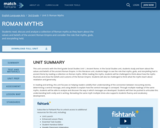
This unit connects with the third grade Social Studies Unit 1, Ancient Rome. In the Social Studies unit, students study and learn about the values and beliefs of the ancient Roman Empire. In this literature unit, students begin to see the role that myths, gods, and storytelling had in ancient Rome by reading a collection on Roman myths. While reading the myths, students will be challenged to think about how the myths illustrate and show the beliefs and customs of the Roman Empire. Students will also be challenged to think what the myths teach about retaliation and generosity.
In reading and writing, this unit focuses on helping readers solidify their understanding of the connection between recounting stories, determining a central message, and using details to explain how the central message is conveyed. Through multiple readings of the same myths, students will be able to analyze and discover the way in which messages are developed. Students will then be pushed to articulate this understanding both orally and in writing. Rereading the same myth multiple times also supports students fluency and vocabulary development.
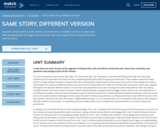
This unit is focused on three classic fairy tales: The Three Little Pigs, The Three Bears, and Little Red Riding Hood. With each fairy tale, students are first exposed to the classic version, familiarizing themselves with the basic plot and lessons. Then students explore the ways authors change setting, characters, and plot while still maintaining the overall essence of the classic story. Some of the changes the authors make reflect the nuances of different cultures and environments, while others are made for entertainment and humor. Either way, students will explore the idea that different authors can use their own perspective and culture to shape the stories they write or retell. By reading multiple versions of the same classic fairy tale, students will also be able to grapple with the bigger lessons of each tale—the importance of not talking to strangers, how hard work and patience pay off, and the importance of respecting others' property and privacy. Over the course of the unit, students will be challenged to think about how each of these unique themes is portrayed and how in each different version of the fairy tale the characters may learn the lesson in slightly different ways. It is our hope that this unit, in connection with others in the sequence, will help students see the power of storytelling and how simple stories can be changed and improved based on an author's ideas and preferences.
In reading, this unit builds directly onto the reading strategies from unit 2. Students will continue to be pushed to be inquisitive consumers of text, asking and answering questions about characters, setting, and plot as they listen to and engage with a text. Students will also continue to work on retelling stories and including key details. Similar to units 1 and 2, students will continue to think deeply about characters and setting and how the details an author includes in the illustration and text help a reader better understand both. Because most of the focuses for this unit are a repeat of similar focuses from units 1 and 2, students should be pushed to a much higher level of rigor and understanding than in previous units. One new focus of this unit, however, is on comparing and contrasting the adventures and experiences of characters in stories. Students will be asked at multiple points to use information they have learned about key events, characters, and setting to compare and contrast different versions of the classic fairy tale. Students should be pushed beyond just superficial comparisons across the different stories. At the end of the unit, students will also have a chance to retell and act out the different fairy tales, putting their own'artistic' spin on the fairy tale.
In writing, students will continue to write daily in response to the text. In unit 2, students began to write answers that correctly answered the questions using facts. In this unit, students will be pushed to continue to focus on correct answers that may show some level of inferential or critical thinking. Students will also begin to learn how to include details from the text in their answers. At this point in the year, it is not important that students have the best evidence but rather that they are including some details that support the answer to the question in one way or another. Structure and grammar feedback during this unit should be based on assessment data from units 1 and 2.
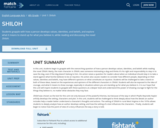
In this unit, students begin to grapple with the overarching question of how a person develops values, identities, and beliefs while reading the novel Shiloh. Marty, the main character in Shiloh, sees someone mistreating a dog and thinks it's his right and responsibility to step in to save the dog, even if the dog doesn't belong to him. His action raises a question for readers about when an individual should step in to take a stand against what he/she believes to be an injustice. His action also causes readers to consider how different people, depending on their values, identities and beliefs, may have different opinions on what constitutes an injustice. Students will be challenged to take a stand on both of these ideas, based on the experiences and opinions of the different characters in Shiloh. Students will also be exposed to the idea of courage, and what it means to show courage, especially in situations where you are standing up for what you believe in. It is our hope that this unit will inspire students to grapple with these questions at a deeper level and understand the power of showing courage to fight for the things they believe in, no matter what obstacles they may face.
Shiloh was chosen as the text for this unit not only because of the powerful themes, but because of the way in which Phyllis Reynolds Naylor artfully develops the setting, characters and plot. In this unit, students will be challenged to think deeply about how the details an author includes help a reader better understand a character's thoughts and actions. The setting of Shiloh in rural West Virginia in the 1970s allows students to deeply analyze how an author develops setting, and how the setting of a text influences the characters. Finally, students will begin to notice how the point of view of a story influences the way a story is told.
Theme: Las identidades públicas y privadas / Community: Chile / These Modules are products of a collaboration dedicated to combining resources to create Modules for Spanish AP for face-to-face and online instruction that can be used easily by any teacher, regardless of experience.The modules are designed for consistency and contain four main proficiency-based tasks along with a vocab-builder task, using the tabs across the top. All other items link to tasks that can be used as needed. There are 12 assignments/resources in each Module to choose from.The tasks focus on skills that are needed for the AP Spanish Language and Culture exam, such as making a cultural comparison, citing sources, and replying to an email. There are multiple ideas for discussion to practice conversation and interpersonal communication.
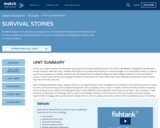
In this unit, students explore the attributes necessary for survival by reading excerpts from Julie of the Wolves, Endangered, Hatchet, and a variety of poems. With each story, students will explore if one needs more physical or mental strength, or a combination of both, in order to overcome an obstacle or problem. Students will also explore how our ability to adapt and make changes impacts our lives and ability to survive. It is our hope that this unit challenges students to think about the way in which they tackle obstacles and the power and influence they have over their own lives.
When analyzing individual stories, students will focus on explaining how scenes fit together and contribute to the overall structure of a story or poem, and summarizing a text and determining theme. After analyzing a story or poem in-depth, students will then practice comparing and contrasting across stories and analyzing the way in which different stories approach similar themes and topics. This unit places a large emphasis on the power of rereading a text in order to build deeper meaning. Over the course of the unit, students will have multiple opportunities to engage with a particular text multiple times in order to analyze and notice author's craft and additional layers of meaning.
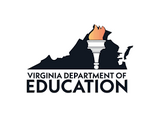
English Instructional Plan – Individuality and Fictional Characters’ Responses to Injustice: Themes and Symbols

In this unit students will explore the difficulties of having a learning disability and how a learning disability influences the way a person feels about themselves by reading the core text, The Wild Book. Throughout the unit students will be challenged to think about multiple thematic topics—believing in ourselves, accepting differences, persevering through challenges, and trusting in family during difficult times. Exploring the themes will allow students to develop a deeper appreciation for people's unique differences and struggles and learn to accept everyone for their strengths. It is our goal that this unit, combined with others in the curriculum, will help students see the world as a diverse place, not just in terms of race but also in terms of abilities, and that no matter what, everyone can be successful.
The text, The Wild Book, was chosen not only for its powerful themes but because Margarita Engle, the award-winning Latina author, uses verse to bring to life a difficult historical period in Cuba. The book tells the story of Margarita Engle's grandmother who grew up in Cuba during a time of lawlessness. Margarita Engle tells her grandmother's story in a way that helps readers build empathy and understanding of the hardships our ancestors may have faced. Simultaneously, students also see the power of poetry and its influence on Cuban culture in the early 20th century. Seeing that despite the hardships the country faced, it was also a place of artistic beauty.
This unit builds on previous units in which students have learned the features of poetry; however, in this unit students begin to see poetry as not just stand-alone poems but as an art form in which a poet can express himself or herself freely. When discussing and writing about poetry, students should be able to refer to the specific structural elements of a poem and explain how the elements enrich the text. This unit also challenges students to deeply analyze how authors develop theme within individual poems and also across a longer work. Students will analyze how characters are developed, how word choice and imagery are used to bring power and meaning to different verse, and how the author uses varying experiences to reveal theme. Doing deep text analysis of the poems on an individual level and also on a more broad level will help students understand the power of the various themes and how the author develops them.
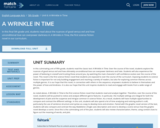
In this culminating unit of fifth grade, students read the classic text A Wrinkle in Time. Over the course of the novel, students explore the nuances of good versus evil and how ultimately unconditional love can overpower darkness and hate. Students will also experience the power of believing in oneself and trusting those around you, by watching the main character's self-confidence evolve over the course of the novel. This novel is the first science fiction novel that students are exposed to over the course of the curriculum. Exposing students to science fiction is important for not only building engagement and reaching a variety of readers, but also for exploring common themes across multiple genres. It is our hope that this novel, in connection with others in the sequence, empowers students to believe in themselves and the power of love and kindness. It is also our hope that this unit inspires students to read and engage with books from a wide range of genres.
As noted above, A Wrinkle in Time is the first science fiction novel that students read and analyze together. Therefore, over the course of the novel, students will be pushed to notice and analyze different genre features. In particular, the multiple settings are integral for both the development of plot and the suspense and intrigue common in science fiction. As a result, students will have multiple opportunities to compare and contrast the different settings. In this unit, students will also spend a lot of time analyzing and noticing author's craft, particularly the use of sentence structure and syntax as a way to develop tone and emotion. Paired with the graphic novel version of the text, students will also compare and contrast the way Madeleine L'Engle uses description and voice to develop a scene versus how the graphic novel develops a scene. Since this is the culminating unit of the year, students will also review characterization, theme, using context clues to figure out the meaning of words, and plot.